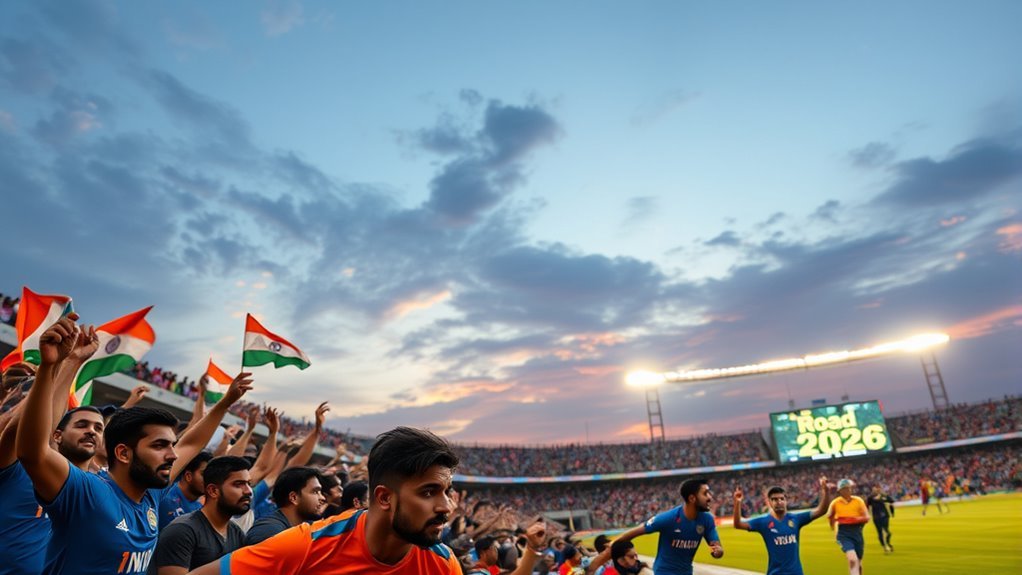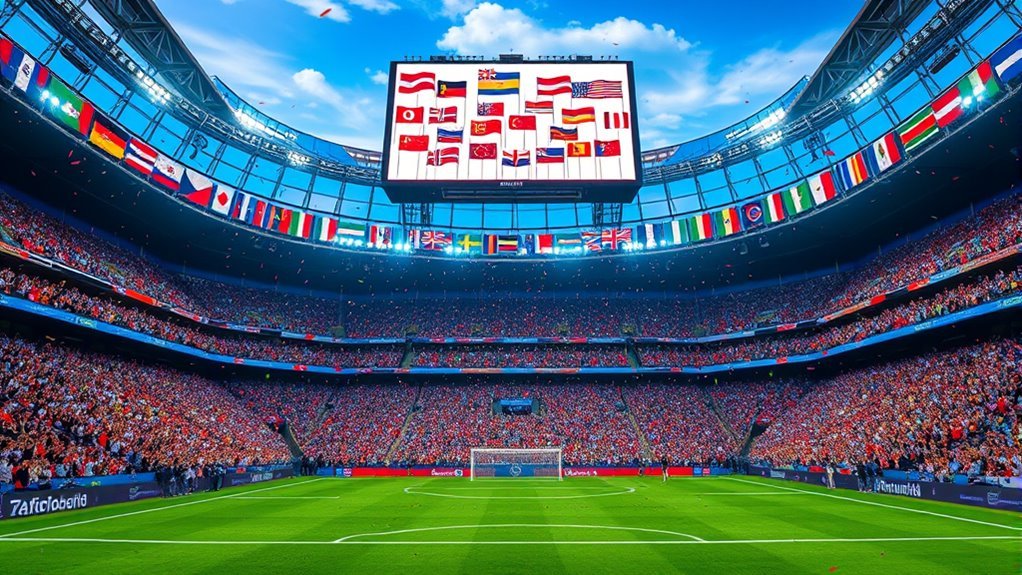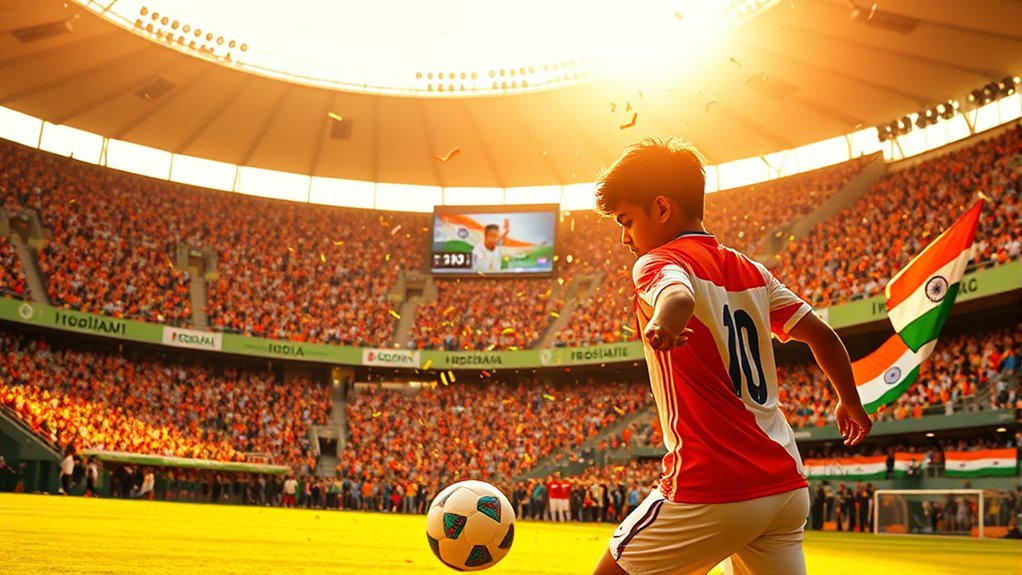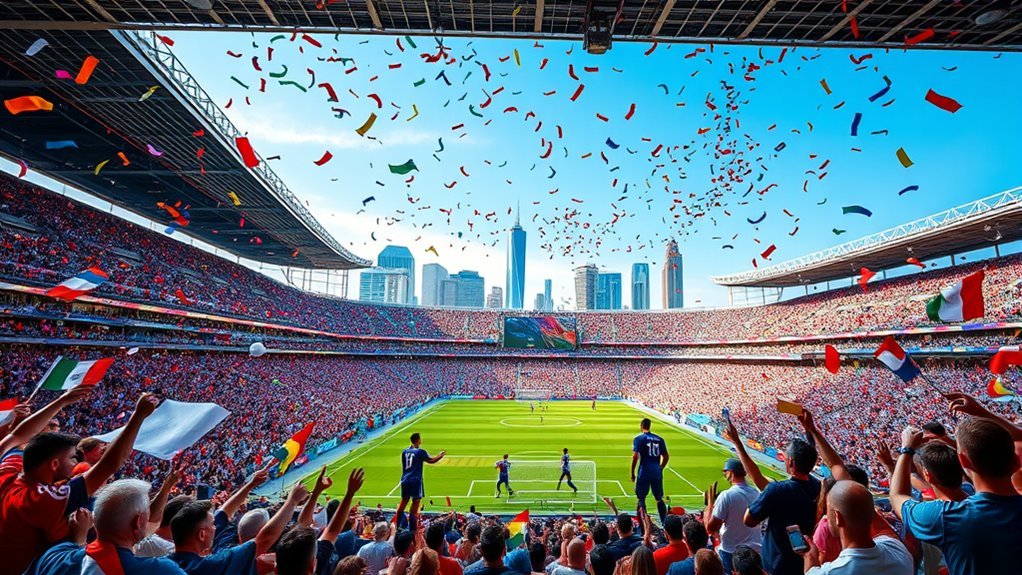India has a realistic chance of qualifying for the FIFA World Cup 2026, especially with the expanded format offering more slots. The country’s football scene is growing, thanks in part to emerging leagues, youth academies, and key players like Sunil Chhetri and Anirudh Thapa. Improved coaching and infrastructure are essential as the national team navigates challenges. With increasing fan support, there’s a sense of optimism in the air. You’ll discover more about the future prospects and developments.
The Current State of Indian Football
Although Indian football has a rich history, its current state reveals a mix of potential and challenges. The emergence of Indian leagues has sparked excitement, yet the need for improved coaching standards and player scouting remains essential. Youth academies are stepping up to nurture talent, but without adequate financial support and sponsorship deals, their impact can be limited. Fan engagement is critical; it’s what fuels the passion for the game. Increased media coverage can elevate the sport’s profile, drawing in more supporters and investors. However, to truly unleash the potential of Indian football, a concerted effort is needed across all levels—from grassroots to the professional leagues. By focusing on these areas, you can help create a vibrant football culture that not only embraces its rich past but also looks to a brighter, more competitive future. The journey might be intimidating, but the spirit of the game lives on, waiting to flourish.
Historical Performance in World Cup Qualifiers
When you look back at India’s World Cup qualifying history, it’s clear there’ve been some memorable moments. From early attempts to pivotal matches that shaped the team’s journey, these experiences have defined Indian football. Let’s explore how these past efforts set the stage for the current qualification campaign.
Past Qualifying Attempts
India’s journey in FIFA World Cup qualifiers has been a mix of hope and disappointment, as the team has struggled to make a significant impact on the global stage. Historical failures have plagued their attempts, but there’s always room for improvement through better qualifying strategies.
Here’s a look at India’s past qualifying attempts:
| Year | Outcome |
|---|---|
| 1950 | Did not participate |
| 1962 | Group stage failure |
| 1970 | Group stage failure |
| 1986 | Failed to qualify |
| 2018 | Failed to qualify |
These attempts highlight the challenges faced by the team. As you reflect on these historical attempts, it’s clear that with the right strategies, India can aspire for a brighter future in world football.
Key Historical Matches
Reflecting on India’s past qualifying attempts reveals some key historical matches that shaped the team’s journey in World Cup qualifiers. One memorable moment was the 1950 qualifier against Italy, where India was forced to withdraw, leaving fans longing for what could’ve been. Fast forward to 1986, when India faced a resolute Hong Kong team, marking a pivotal match that showcased their potential. Another significant encounter was during the 2002 qualifiers against Iran, where a spirited performance ignited hope among supporters. These historical matches not only defined India’s quest for World Cup glory but also fueled a passionate desire for freedom in footballing success. Each game, a reflection of resilience, reminds us of the dream that still echoes in every fan’s heart.
The Impact of the Expanded Tournament Format
As the FIFA World Cup expands to include more teams, its impact on nations like India can’t be overlooked. This expanded format changes tournament dynamics, opening doors for countries that have historically struggled to qualify. For you, this means a greater chance for India to showcase its talent on the world stage.
With more spots available, teams like India can dream bigger, pushing their players to improve and compete at higher levels. The expanded format encourages investment in grassroots football, which is essential for long-term development. You might find that with more competitive matches, players gain invaluable experience, sharpening their skills and fostering a winning mentality.
Moreover, the excitement surrounding qualification could ignite a deeper passion for football across the nation. As fans rally behind their team, India’s football culture can flourish, making the dream of World Cup participation feel more attainable than ever.
Key Players to Watch in the Coming Years
Which players have the potential to shine on the international stage as India aims for World Cup 2026 qualification? As the landscape of Indian football evolves, several emerging talents are stepping up, showcasing skills that could lead India to glory. You’ll want to keep an eye on these players who have the potential to form impactful player combinations:
- Sunil Chhetri – A veteran whose experience can guide younger players.
- Rahul Bheke – A solid defender with an eye for initiating attacks.
- Anirudh Thapa – A dynamic midfielder known for his creativity.
- Liston Colaco – An exciting forward with the pace to outmaneuver defenses.
These players, along with others, are essential to building a cohesive team capable of challenging on the world stage. Their development and synergy will be critical for India’s aspirations in the upcoming years.
The Role of Coaching and Management
While the players on the pitch often grab the spotlight, the role of coaching and management is equally essential in steering India’s journey toward FIFA World Cup 2026 qualification. You need to recognize that effective coaching strategies can reveal the potential of individual players and the team as a whole. A coach who understands the unique strengths of each athlete can create a more cohesive and adaptable squad.
Moreover, a clear management philosophy sets the tone for the team’s culture and goals. It encourages a sense of unity and purpose, fostering an environment where players feel empowered to express themselves. This freedom can lead to creative play and innovative tactics on the field.
In the end, when coaching strategies align with a strong management philosophy, it can transform the team’s performance and enhance India’s chances of making history in the World Cup.
Infrastructure and Grassroots Development
To succeed in qualifying for the FIFA World Cup 2026, India’s focus on infrastructure and grassroots development can’t be overlooked. You’ll want to see a strong foundation laid for the future of football in the country. This means prioritizing both infrastructure investment and grassroots initiatives.
Consider these key areas:
- Building state-of-the-art training facilities to nurture local talent.
- Creating community football programs that engage children and youth.
- Developing league systems that support regional clubs and talent progression.
- Encouraging partnerships with global football organizations to enhance knowledge and skills.
Challenges Facing the National Team
As you think about India’s journey to the FIFA World Cup 2026, you’ll notice several challenges the national team faces. Issues with infrastructure development, gaps in player development programs, and limited competitive international exposure all play a significant role in their quest for success. Addressing these hurdles is essential for fostering a stronger footballing future.
Infrastructure Development Issues
Although India’s footballing ambitions are on the rise, significant infrastructure development issues pose challenges for the national team as it aims for FIFA World Cup 2026 qualification. Without addressing these concerns, the dream may remain just that. You need to focus on:
- Upgrading stadium facilities to meet international safety standards
- Enhancing training infrastructure for better preparation
- Establishing youth academies to nurture local talent
- Improving transportation logistics for regional development
These factors are essential for urban planning and the overall growth of football in India. Without solid investment strategies, the national team might struggle to reach its full potential. It’s time to prioritize these infrastructure developments to pave the way for success on the world stage.
Player Development Programs
While India’s footballing landscape is evolving, the national team faces significant challenges in its player development programs. One major hurdle is the inconsistency in youth academies across the country. You’ll find some promising setups, but many lack the necessary resources and infrastructure to nurture talent effectively. Furthermore, talent scouting often falls short, leaving potential stars unnoticed. Young players deserve the chance to shine, but without a robust system in place, their paths can be obstructed. To truly compete on the global stage, it’s essential for India to invest in these programs and create a unified approach. By doing so, you’ll empower the next generation and pave the way for a brighter future in Indian football.
Competitive International Exposure
Competitive international exposure is essential for the growth of India’s national football team, but several challenges hinder their progress. The lack of regular international friendlies and participation in competitive leagues limits players’ experience against top-level competition.
- Limited access to established footballing nations for friendlies
- Insufficient support for players to join competitive leagues abroad
- Inconsistent performance in regional tournaments
- Financial constraints affecting travel and training camps
These obstacles hold back the national team’s ability to evolve and compete on the world stage. To truly thrive, India needs to embrace opportunities for international exposure, pushing players to sharpen their skills and gain the confidence necessary for the FIFA World Cup 2026 qualification journey.
The Importance of Fan Support and Engagement
When fans actively engage with their national team, it creates an electric atmosphere that can greatly impact the players’ performance. Your support fuels the players’ passion and determination, and it’s vital to foster fan engagement through various avenues. Community support can thrive with local initiatives, promoting youth involvement in football. When you attend matches, your presence boosts morale and encourages sponsorship deals that can enhance the team’s resources.
Social media plays a pivotal role in connecting fans and building fan clubs, making it easier to rally support. Merchandise sales also reflect your commitment and help generate funds for the team. Increased media coverage driven by enthusiastic fans amplifies the visibility of Indian football. So, whether it’s cheering in the stands or sharing your passion online, your engagement is essential. It’s time to come together, support our team, and create a wave of enthusiasm that can lead India toward FIFA World Cup 2026 qualification!
Optimism and Future Prospects for Qualification
As fans rally behind the national team, there’s a palpable sense of optimism about India’s prospects for qualifying for the FIFA World Cup 2026. The growing enthusiasm is fueled by various factors that inspire hope and excitement among supporters like you.
- Investments in youth academies are nurturing future talent.
- Increased fan engagement is building a stronger community around football.
- The emergence of skilled players is elevating the national squad’s performance.
- Support from local clubs is fostering a competitive spirit.
These elements combine to create a vibrant atmosphere, where every cheer and chant contributes to the dream of World Cup qualification. With each match, you can feel the momentum building, and it’s clear that the journey ahead is filled with potential. Additionally, the focus on enhanced endurance through training and cross-training methods can further empower players to perform at their best. Together, let’s embrace this wave of optimism and keep the passion alive, believing that your support can help propel India to new heights on the international stage.
Frequently Asked Questions
What Is the Qualification Process for the FIFA World Cup 2026?
To qualify for FIFA World Cup 2026, you’ll need to meet the qualification criteria through regional tournaments. Each region has its own process, so stay informed and ready to support your team’s journey!
How Many Teams Will Represent Asia in the 2026 World Cup?
In 2026, Asia will have eight slots for the World Cup, enhancing Asian representation. You’ll see more teams competing, giving fans across the continent a greater chance to cheer for their nations on the global stage.
What Are India’s Chances Based on FIFA Rankings?
You might think India’s FIFA rankings are too low, but their recent performance shows improvement. If they maintain momentum and strengthen their squad, there’s a chance they could rise and surprise everyone in the qualifiers.
When Will the World Cup Qualifiers Start for India?
The qualifier schedule for India kicks off in late 2023, with matches held across various venues. You’ll want to stay updated on the dates and locations to support your team’s journey towards the World Cup.
How Has India Performed in Previous World Cup Qualifiers?
India’s previous performances in World Cup qualifiers have been challenging, reflecting a historical context of struggle. You’ll notice a mix of spirited efforts and setbacks, but the passion for football continues to inspire hope for the future.




